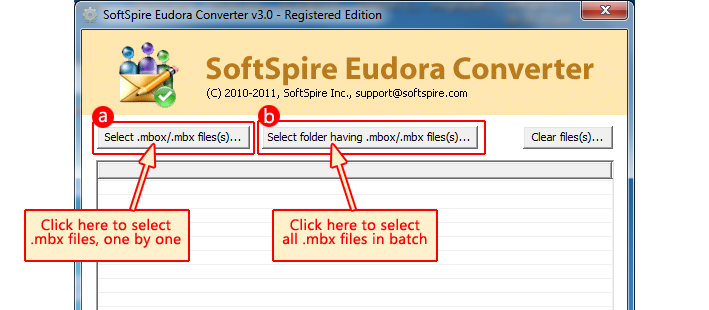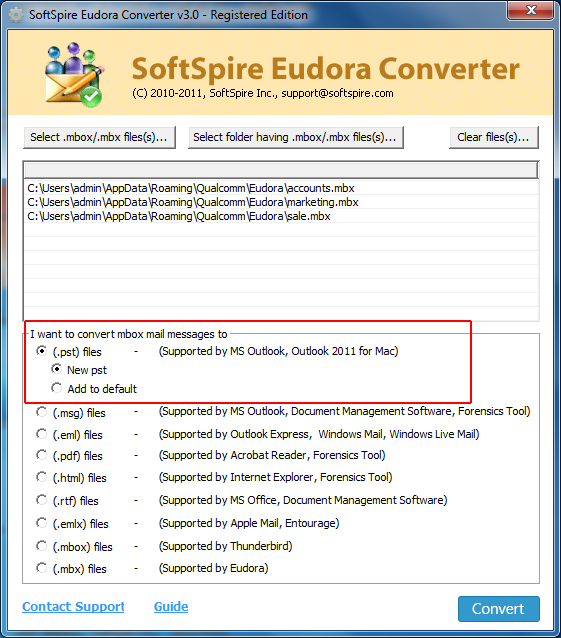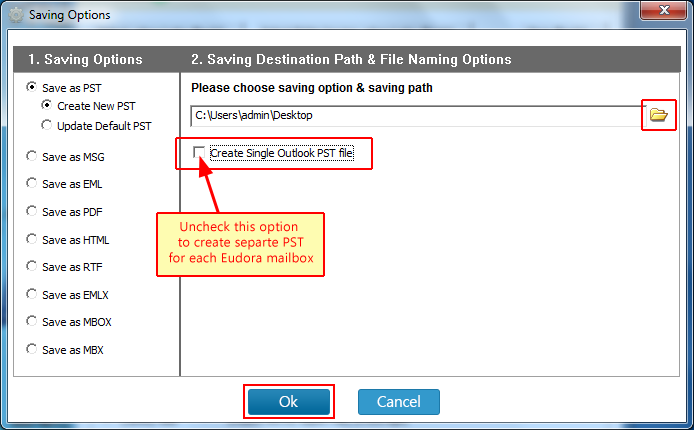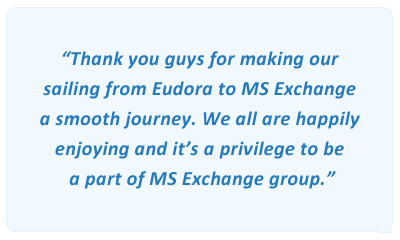Eudora to Exchange Migration ~ Treasured Experiences
Switching from one email app to another always need some pre-planning and Eudora to Microsoft Exchange Migration is no different. Considering the scalability of the whole conversion process and the risks involved, sticking to manual process can't be a feasible idea.
Using an external utility is a better idea in such a situation, where the migration project is pre-planned as step-by-step process.  is perfect here as it supports to convert email data from Eudora to Exchange, by first importing them to
is perfect here as it supports to convert email data from Eudora to Exchange, by first importing them to  which can further be imported into MS Exchange 2010, 2013, 2016 etc.
which can further be imported into MS Exchange 2010, 2013, 2016 etc.
Here is a problem shared by one of our US based client and how the software played a major role in the whole Process.
Hi I am planning to replace my 15 years old Eudora with MS Exchange 2010, but I have a few questions before I take further action :
- My company has around 1000 employees (both current and ex employees - as all data is important that's why I have counted ex-employees too), having 1940 GB of data. I want this whole data in MS Exchange without any modification or damage.
- Will I get all the mailboxes as separate file or one single
 for all the mailboxes?
for all the mailboxes? - How about proceeding

 file in MS Exchange?
file in MS Exchange? - Once I have all the
 files, how to further proceed with importing them in Exchange 2010?
files, how to further proceed with importing them in Exchange 2010? - Which license will best suit me?
Our Technical Support here thoroughly studied the whole case and created a step by step plan to help them proceed with Eudora to Exchange migration.
First of all, it was suggested for them to first test the software using its demo edition, which converts first 25 messages from each selected Eudora Mailbox. After getting successful results with Demo, the company Engineer (along with technical support) then proceeded with the large scale Eudora ~ Microsoft Exchange Server migration project, involving 1940 GB of Eudora Mailbox data.
The software easily managed to solve their problem of having separate  for each Eudora mailbox. After selecting the
for each Eudora mailbox. After selecting the  as desired file format, a new window appears where it provides a checkmark (Create Single Outlook PST file) just below the saving path. Selecting or deselecting this checkmark decides how the
as desired file format, a new window appears where it provides a checkmark (Create Single Outlook PST file) just below the saving path. Selecting or deselecting this checkmark decides how the  file gets created, selecting this checkmark will create one
file gets created, selecting this checkmark will create one  file for all the Eudora files. Since here the requirement is for separate
file for all the Eudora files. Since here the requirement is for separate  files for each mailbox, this option needs to be unchecked.
files for each mailbox, this option needs to be unchecked.
Import Email Data from Eudora to Exchange!
Since they wanted to migrate Multiple Eudora mailboxes to MS Exchange, a utility was required that would help them select all the mailboxes at once. The whole process was divided into two major stages :
- Import Eudora Mailboxes to
 , using some intermediary conversion tool, i.e.,
, using some intermediary conversion tool, i.e., 
- Once the
 files are obtained for each Eudora mailbox, import them into MS Exchange Server
files are obtained for each Eudora mailbox, import them into MS Exchange Server
Using  , they were able to convert all their Eudora Mailboxes to
, they were able to convert all their Eudora Mailboxes to  , very easily. As the software provides auto-detection of Eudora files, conversion became even more simpler and quite quicker.
, very easily. As the software provides auto-detection of Eudora files, conversion became even more simpler and quite quicker.
Steps for Importing Eudora Mailboxes Data
- After launching, the software provides two options to select Eudora files.

- After getting the MBX files, lined up for conversion, select
 files as the conversion option. Here also, two sub options are provided : Create a new
files as the conversion option. Here also, two sub options are provided : Create a new  or Add to the default
or Add to the default  file. Since here, separate file for each Eudora Mailbox is required, choose the first option. And Click on Convert Button.
file. Since here, separate file for each Eudora Mailbox is required, choose the first option. And Click on Convert Button.

- Choose the location to save the converted files
- Below the destination route, a checkbox appears Create Single File. Uncheck this option for getting separate files for each selected MBX file. If you want to save all the MBX files in one file, then keep this option checked. Finally click on OK button.

- Once the OK button is pressed, the software starts the conversion process, showing the conversion status of each mailbox. And after successful conversion, shows the message as Complete.
The whole Eudora migration process was done using Unlimited Licence of the software (99 USD), which is a commercial product, supporting large scale migrations.
Get Ready to Import Eudora Email ~ Exchange Server
Once all the Eudora mailboxes were saved as  file, they then proceeded with transferring them to Microsoft Exchange server, 2010 edition. All the files were imported from migration machine to Exchange server user mailboxes, using a suitable cmdlet on their MS Exchange shell. The cmdlet used was as follows :
file, they then proceeded with transferring them to Microsoft Exchange server, 2010 edition. All the files were imported from migration machine to Exchange server user mailboxes, using a suitable cmdlet on their MS Exchange shell. The cmdlet used was as follows :
New-MailboxImportRequest -Mailbox "John Smith" -FilePath
\\someFileServer\E$\someFolder\john_smith.pst –TargetRootFolder "Migrated Emails"
This way all the Eudora mailboxes were transferred to Exchange Server 2010, by importing all the resultant files into MS Exchange shell (single file at one time).
When both the original and converted files were compared at source location (Eudora-original files) and desitnation location (MS Exchange-converted  file) , it was found that :
file) , it was found that :
- All the emails were imported with correct email properties having accurate meta details (to, cc, sent/received date, subject, read/unread status), formatting (HTML, RTF), message contents (links, embedded images), folder hierarchy.
- Even the attachments were properly imported, with accurate file format.
- All the Eudora mailboxes were precisely imported to MS Exchange, without any loss of data.
